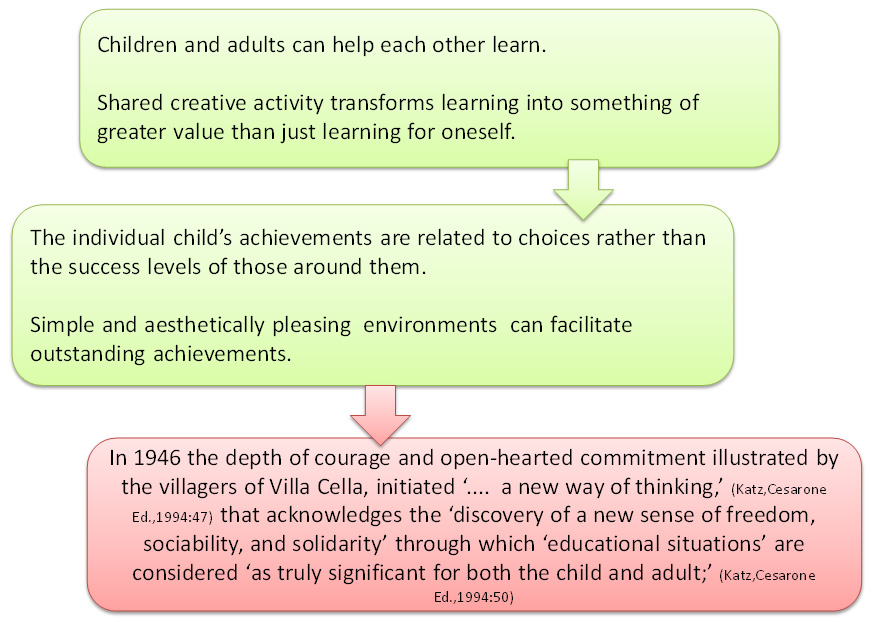The Reggio Preschool Pedagogy
- In 1946 the villagers of Villa Cella, Reggio, Italy, sought to create a culturally progressive experience for their new generation of young children.
- The cooperative efforts of the working community, built and funded a specially designed nursery school for their children.
‘In every brick of “the people’s preschool” there was trust, awareness, willingness, and hope.’ (Barazzoni,2000:29)
- They wanted to restore the young children’s rights to choose for themselves and joyfully retain: their liberty, a love of learning & enthusiasm to participate with extreme creativity.
- They inspired Socialised Management, Democracy, Young children as Liberated Citizens.
- This ‘profound illustration of humanity’ founded ‘a culture and professionality’ (Barazzoni,2000:28) based on ‘the richness and concreteness’ (Reggio Children,2000:9) of children’s ‘ideas, theories, questions and opinions’. (Katz,Cesarone,1994:25)
A ‘creative and reflective pedagogy’ (Bancroft,2007:5)
of listening and relationships. (Abbot,Nutbrown,2001:128)
The roles of the Reggio teachers
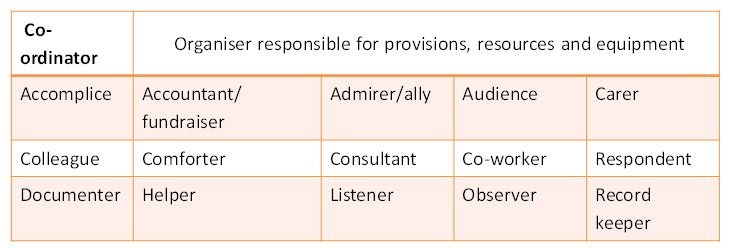
A pedagogy imbued with open-hearted authenticity ‘…….the activity of making projects conceived as functional interaction between needs, resources, conditions, knowledge and method.’ (Reggio Children 2001:56)
Reggio teachers feel it is important to focus on beauty, art and aesthetic value.

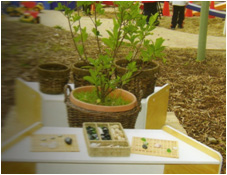

‘the attention to detail and beauty’ ‘foster the children’s aesthetic sense’ and illustrates ‘an “amiable” environment where relationships can flourish.’ (Frazer, Gestwiki,Ed. 2002:89)
Children are endowed with ‘genius, talent and creativity…..So to awaken his genius, you need to open his heart, remove complexes, tension and fear.’
The more traditional issues have been transformed into :-
 How well the teacher can listen to what and how the children want to learn and achieve, feeling comfortable with unpredictable activity and creative styles of communication.
How well the teacher can listen to what and how the children want to learn and achieve, feeling comfortable with unpredictable activity and creative styles of communication.
Successful scaffolding within the Zone of Proximal Development (Vygotsky) where the ‘emphasis is on relationship and reciprocity and the outcome emerges as it unfolds.’ (Frazer, Gestwiki,Ed. 2002:86)
 How to embrace changes and integrate personal experience with the unique specialness of child initiated learning.
How to embrace changes and integrate personal experience with the unique specialness of child initiated learning.
Facilitating an inherently open-ended learning environment.
 An Emergent Curriculum – children working at their own natural pace developing their own style and method for learning.
An Emergent Curriculum – children working at their own natural pace developing their own style and method for learning.
Sharing of ideas & possibilities without an attachment to a preconceived result.
Consideration of what others think – the child, the adult and the other children.
Examples of Working Practice:-
Sometimes the adults do not interrupt or disturb the children.
‘…….two little girls spent 3 hours or so playing together with a collection
of red and pink glass objects displayed on a lighter box.’
(Abbot,Nutbrown,2001:69)
The adults facilitate specially designed environmental support. 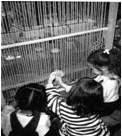
‘……children sometimes need to ‘flit’. (Abbot,Nutbrown,2001:69)
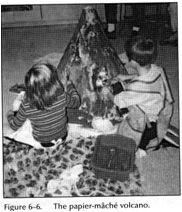 ‘…the initial observation of the idea warms up’ the children’s and the Adults’ ‘awareness of what could be done.’ (Frazer, Gestwiki,Ed. 2002:177)
‘…the initial observation of the idea warms up’ the children’s and the Adults’ ‘awareness of what could be done.’ (Frazer, Gestwiki,Ed. 2002:177)
When the children wanted to make their paper-mache mountain into a volcano the assisting adults helped the children investigate things that would safely explode in the classroom.’
(Frazer, Gestwiki,Ed. 2002:143)
‘Interactions between children and either an adult or a child who is more confident act as scaffolding to nudge children to go beyond what they can achieve on their own.’ (Frazer, Gestwiki,Ed. 2002:66) .

Freedom within creative activity releases children from following
conventional thinking and structures of behaviour.
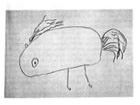 ‘Frederica (age three) knows horses have four legs; she turns the piece of paper over and draws the other two legs on the reverse side’ (Rinaldi,2006:115) illustrating a cognitive level of expression bridging II and III dimensional creativity.
‘Frederica (age three) knows horses have four legs; she turns the piece of paper over and draws the other two legs on the reverse side’ (Rinaldi,2006:115) illustrating a cognitive level of expression bridging II and III dimensional creativity.
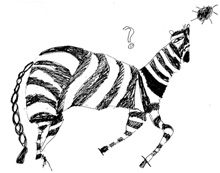 Encouraging open ended questions of enquiry.
Encouraging open ended questions of enquiry.
‘In the shadow of the zebra can you see the white stripes
or the black stripes better?’ (Reggio Children,2000:89)
Reggio teachers foster ‘the children’s competence by explicitly teaching techniques.’
One child was unable to successfully use a wire cutting tool, silently the adult intervened to demonstrate. On this occasion the adult chose to provide a demonstration without any verbal commentary. (Lewin Benham,2006:16)
Adults sharing personal knowledge and experience through their wider access to resources,
The children built a cityscape right underneath the pictures of
the tall buildings.
Another teacher added a mirrored platform …… (Frazer, Gestwiki,Ed. 2002:205)
Inappropriate adult input can be ignored
The teachers hypothesized that a possible next path might be birds, so they brought in branches, nests and little bird figures.
‘But continued careful attention to the play convinced them that this was not the direction to pursue…….the play was still about being tall, being up high’ (Frazer, Gestwiki,Ed. 2002:205)
Extending investigation into the community. Emergent, open ended, ‘child initiated, adult framed’. (100 Voices: DVD)
A visit to a water tower in a nearby city park facilitated III dimensional creative work
Freedom of time and space and use of materials for difficult and challenging projects that may or may not be successfully completed.
Using clay the children began to build the water tower brick by brick, the children were really motivated ‘ …co-constructing as group members learning from one another’ (Frazer, Gestwiki,Ed. 2002:94)
Integrating II and III dimensional representation as they built, they compared their sketches and referred to the drawings like blueprints. (Frazer, Gestwiki,Ed. 2002:207)
Very special worldly experience.
Going to see the space needle.
‘They took the elevator up and experienced real height and different perspectives.’ (Frazer, Gestwiki,Ed. 2002:204-207)
The environment ‘acts as the third teacher’. (Frazer, Gestwiki,Ed. 2002:99)
Parents can provide profound, timely and appropriate support.
The perfect ending was provided when a parent invited the class to the building downtown where he worked.
Building a pyramid of related experiences.
It was one of the tallest buildings in Seattle, looking down on both the water tower and the space needle. (Frazer, Gestwiki,Ed. 2002:208)
The emergent curriculum within The Height Project illustrates
‘….our need as individuals and as a society to engage in a co-operative learning adventure with others, both children and adults.’ (Katz,Cesarone,Ed.,1994:36)
‘Giovanni’s 3-dimentional construction ‘The Mountains of Past and Future’
‘The 100 languages of children’ help children communicate creative thinking skills that are beyond their level of verbal communication.
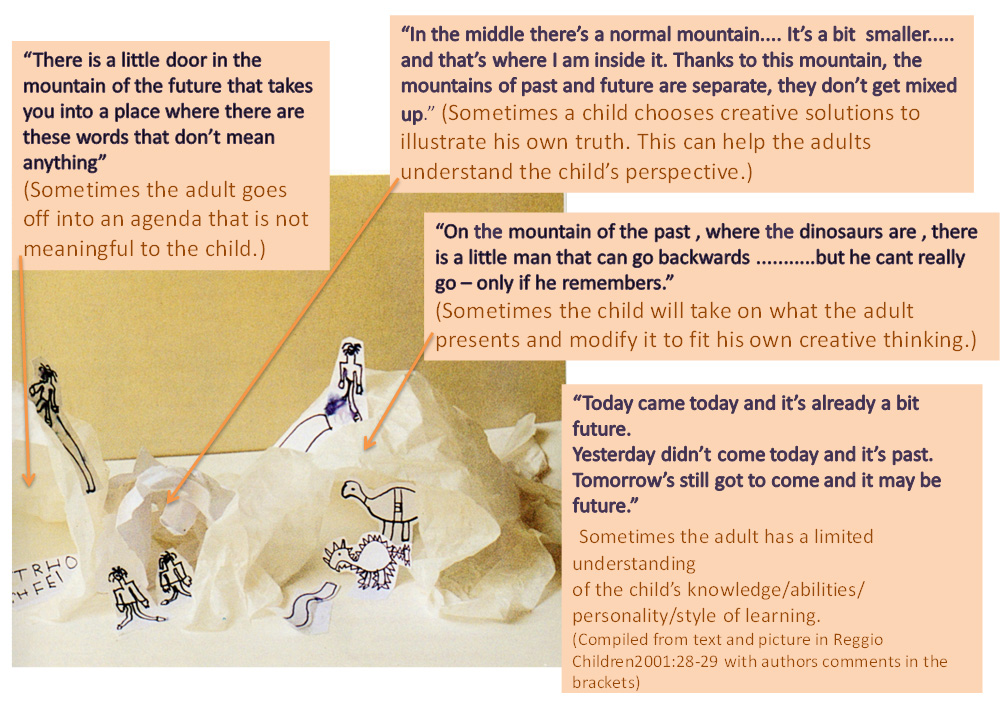
A Child Initiated Emergent Curriculum
An ‘exploration of excellence in early childhood education.’
Working together as a team respectfully collaborating on all levels of interaction, (Frazer, Gestwiki,Ed. 2002:92)
…addressing the day to day quality of children’s lives’ (Katz,Cesarone,1994:17)

The teacher is called to structure the educational experience primarily as it evolves………. capture those vital and significant events, as they appear …(Reggio Children,2000:8) consolidated, unify and empower child-initiated learning through a commitment to ‘developmentally appropriate practices’ (Katz,Cesarone,1994:17) moulded into the very foundations of a community based child centred approach.
The Reggio approach appears to promote and justify a philosophy that:-
